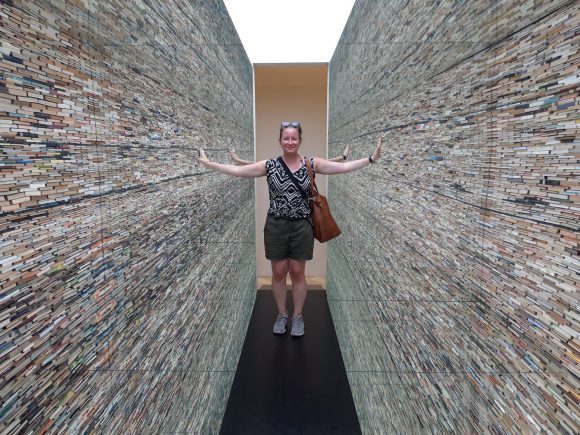
Laura Mononen experiencing a creative ”world flow” in the art installation ‘Passage’ by Matej Kren in Bratislava | © Kati Niiles
By Sandra Ortellado, IIASA 2018 Science Communication Fellow
If fashion is the science of appearances, what can beauty and aesthetics tell us about the way we perceive the world, and how it influences us in turn?
From cognitive science research, we know that aesthetics not only influence superficial appearances, but also the deeper ways we think and experience. So, too, do all kinds of creative thinking create change in the same way: as our perceptions of the world around us changes, the world we create changes with them.
From the merchandizing shelves of H&M and Vero Moda to doctoral research at the Faculty of Information Technology at the University of Jyväskylä, Finland, 2018 YSSP participant Laura Mononen has seen product delivery from all angles. Whether dealing with commercialized goods or intellectual knowledge, Mononen knows that creativity is all about a change in thinking, and changing thinking is all about product delivery.
“During my career in the fashion and clothing industry, I saw the different levels of production when we sent designs to factories, received clothing back, and then persuaded customers to buy them. It was all happening very effectively,” says Mononen.
But Mononen saw potential for product delivery beyond selling people things they don’t need. She wanted to transfer the efficiency of the fashion world in creating changes in thinking to the efforts to build a sustainable world.
“Entrepreneurs make change with products and companies, fashion change trends and sell them. I’m really interested in applying this kind of change to science policy and communication,” says Mononen. “We treat these fields as though they are completely different, but the thing that is common is humans and their thinking and behaving.”
Often, change must happen in our thinking first before we can act. That’s why Mononen is getting her doctorate in cognitive science. Her YSSP project involved heavy analysis of systems theories of creativity to find patterns in the way we think about creativity, which has been constantly changing over time.
In the past, creativity was seen as an ability that was characteristic of only certain very gifted individuals. The research focused on traits and psychological factors. Today, the thinking on creativity has shifted towards a more holistic view, incorporating interactions and relationships between larger systems. Instead of being viewed as a lightning bolt of inspiration, creativity is now seen as more of a gradual process.
New understandings of creativity also call on us to embrace paradoxes and chaos, see ourselves as part of nature rather than separate from it, experience the world through aesthetics, pay careful attention to our perception and how we communicate it, and transmit culture to the next generation.
Perhaps most importantly, Mononen found in her research that the understanding of creativity has changed to be seen as part of a process of self-creation as well as co-creation.
“The way we see creativity also influences ourselves. For example if I ask someone if they are creative, it’s the way they see themselves that influences how creative they are,” says Mononen. “I have found that it’s more crucial to us than I thought, creativity is everywhere and it’s everyday and we are sharing our creativity with others who are using that to do something themselves and so on.”
This means on the one hand that we use our creativity to decide who we are and how we see the world around us for ourselves. But it also means that the outcomes and benefits of creativity are now intended for society as a whole rather than purely for individuals, as it was in the past. It may sound like another paradox, but being able to embrace ambiguity and complexity and take charge of our role in a larger system is important for creating a sustainable future.
“From the IIASA perspective this finding brings hope because the more people see themselves as part of systems of creating things, the more we can encourage sustainable thinking, since nature is a part of the resources we use to create,” says Mononen.
Mononen says a systems understanding of creativity is especially important for people in leadership positions. If a large institution needs new and innovative solutions and technology, but doesn’t have the thinking that values and promotes creativity, then the cooperative, open-minded process of building is stifled.
Working in both the fashion industry and academic research, Mononen has encountered narrow-minded attitudes towards art and science firsthand.
“Communicating your research is very difficult coming from my background, because you don’t know how the other person is interpreting what you say,” says Mononen. “People have different ideas of what fashion and aesthetics are, how important they are and what they do. Additionally, scientific concepts are used differently in different fields.”
“We are often thinking that once we get information out there, then people will understand, but there are much more complex things going on to make change and create influence in settings that combine several different fields.” says Mononen.
For Mononen, the biggest lesson is that creativity can enhance the efforts of science towards a sustainable world simply by encouraging us to be aware of our own thinking, how it differs from that of others, and how it affects all of us.
“When you become more aware of your ways of thinking, you become more effective at communicating,” says Mononen. “It’s not always that way and it’s very challenging, but that’s what the research on creativity from a systems perspective is saying.”

You must be logged in to post a comment.